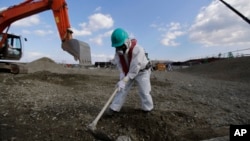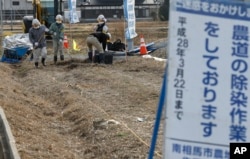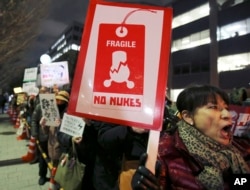Japanese Prime Minister Shinzo Abe and Emperor Akihito led a five-year commemoration service Friday for victims of the massive 2011 earthquake and tsunami that set off one of the world's worst nuclear disasters.
Bells rang out in Tokyo and people across Japan bowed their heads in a moment of silence at 2:46 p.m., the exact time the 9.0-magnitude quake struck offshore. The quake generated a series of tidal waves, some as high a 17 meters, that devastated much of the island’s eastern coastline and killed nearly 20,000 people.
The two leaders bowed in front of a stage full of flowers in a Tokyo ceremony with 1,200 people in attendance, including survivors from the stricken area.
"In the past, our nation suffered countless disasters that could be described as national crises, but overcame them each time with determination and hope. I vow once again that we will follow hand in hand in the footsteps of our forefathers and continue to move forward," Abe said.
Radiation levels
The tsunami disabled the Fukushima Dai-ichi nuclear power plant, causing the worst nuclear disaster since the 1986 meltdown at the Chernobyl plant in Ukraine. Three of the Fukushima's reactors were breached, causing a nuclear meltdown that emitted large amounts of radiation across the surrounding area, contaminating water, food and the air.
More than 600,000 people were evacuated from nearby towns. Some 10 percent of the residents still live in temporary housing across the Fukushima prefecture.
"Efforts are being made to improve the situation, but my heart aches at the thought that there are still people who cannot return home," said Emperor Akihito at Friday’s ceremony.
Lasting damage
Cleanup of the Fukushima plant is ongoing and has been slowed by malfunctioning robots that must be used in the damaged buildings where high radiation levels make it too dangerous for humans to operate.
The environmental group Greenpeace says the Fukushima disaster was responsible for the single largest release of radioactivity into the ocean and has damaged the genetic DNA of wildlife in the affected area.
Some researchers are also reporting a dramatic rise in thyroid cancer among children in the Fukushima prefecture, although the Japanese government disputes this claim.
Japan has spent billions of dollars in assistance and in decontamination and reconstruction efforts.
Japan's Ministry of Agriculture, Forestry and Fisheries recently claimed that 74 percent of affected farmland in east and northeastern Japan has recovered and is no longer contaminated with radiation.
However, in the hardest-hit Fukushima region, the farmland restoration rate was only 33 percent.
Decontamination efforts
Abe promised Thursday to increase decontamination efforts to end most of the evacuation orders still affecting 100,000 Fukushima residents, and allow them to return to their homes.
Some environmental organizations, such as Greenpeace, oppose this plan. They argue that radiation levels are still high in the forest areas that cover 70 percent of Fukushima, and that radiation continues to leak into the underground water supply and out into the Pacific Ocean.
Lifting these evacuations, Greenpeace said, would benefit Abe’s political supporter, Tokyo Electric, by ending its obligation to provide compensation, at the cost of potentially exposing residents to increased risks.
"They lost everything and they’re going to lose even the small amount of compensation that Tokyo Electric is reluctantly paying," said Shaun Burnie, a nuclear specialist with Greenpeace.
Nuclear legacy
Japan’s reliance on nuclear power remains a divisive issue five years after the tsunami caused the Fukushima disaster.
Supporters like Abe say resource-poor Japan needs nuclear power to remain economically competitive and to reduce carbon emissions related to global warming.
Japan initially shut down all the country’s nuclear plants after the meltdown, forcing energy companies to turn to more expensive fossil fuels.
Abe and utility companies have been pushing to get reactors back in operation. However, a Japanese court this week ordered the shutdown of two nuclear reactors previously declared safe under post-disaster safety rules.
Anti-nuclear sentiment in Japan still runs high. Opponents include former Prime Minister Naoto Kan, who held office during the Fukushima disaster.
At one point during the meltdown, the Japanese government was considering evacuating 50 million people, which, Kan said, "would have been like a losing a huge war."
Opponents say the enduring lesson of the man-made nuclear disaster is that the danger of decades of widespread radioactive contamination far outweigh the benefits offered by nuclear energy.
If any good has come from this tragedy, they say, it is the increased public support for developing alternative renewable, clean energy sources such as wind, solar and geothermal power.
"The 21st century will be one based upon renewable energy. And that is a suitable homage and testament to the many people in Japan who are still continuing to suffer from the Fukushima nuclear accident five years on and will continue to suffer for a decade ahead," said Burnie.












